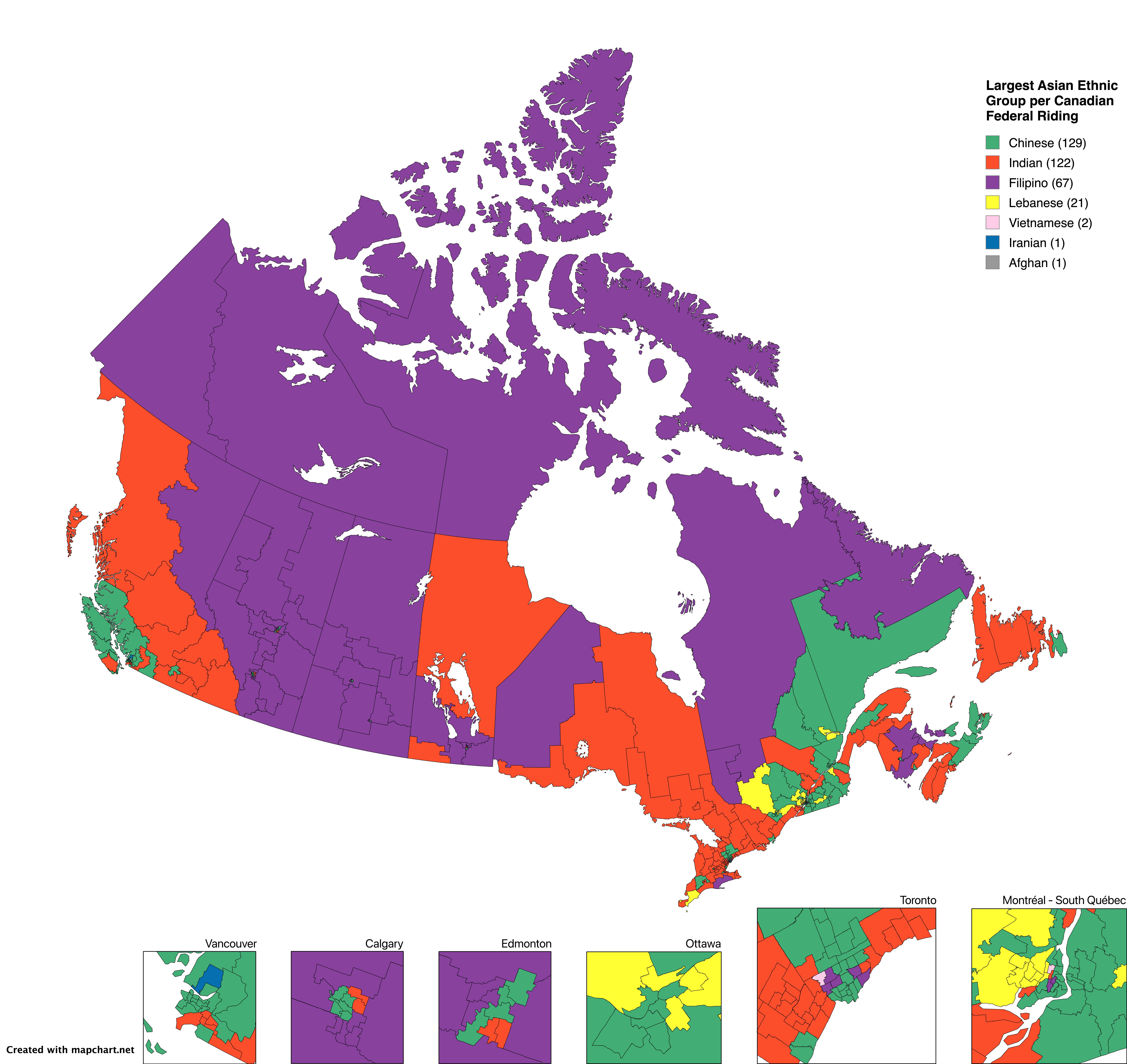Largest Asian Ethnic Group per Canadian Federal Riding Map


Marcus Rodriguez
Historical Geography Expert
Marcus Rodriguez specializes in historical cartography and geographic data analysis. With a background in both history and geography, he brings unique...
Geographic Analysis
What This Map Shows
The "Largest Asian Ethnic Group per Canadian Federal Riding" map provides a detailed visualization of the predominant Asian ethnic groups residing in various federal electoral districts across Canada. By utilizing data from the Canada Census, this map not only highlights the diversity of Asian communities in the country but also illustrates how these demographics are distributed geographically. Each federal riding is color-coded to represent the largest Asian ethnic group, allowing viewers to easily identify where significant populations of specific groups, such as Chinese, Indian, Pakistani, Filipino, and others, are concentrated.
Transitioning from the visualization, we delve into the rich tapestry of Asian demographics in Canada. With a history that spans several decades, Asian immigration has played a critical role in shaping the cultural landscape of the nation.
Deep Dive into Asian Demographics in Canada
Asian Canadians represent one of the fastest-growing populations in the country. According to the 2021 Census, individuals of Asian descent, including South Asian, East Asian, and Southeast Asian backgrounds, accounted for over 17% of the Canadian population. This shift is not merely a number; it reflects the dynamic cultural influences and contributions these communities have made to Canadian society.
Interestingly, Toronto and Vancouver are often at the forefront of this demographic trend. In Toronto, the largest Asian ethnic group is Chinese, which is evident in the vibrant neighborhoods like Chinatown and Markham. Conversely, Vancouver also showcases a significant Chinese population, but it is home to a noteworthy South Asian community as well, particularly in areas like Surrey.
Have you noticed that the largest Asian ethnic groups differ significantly from one region to another? For example, in Alberta, the Punjabi community is the most prominent, while in Manitoba, it is the Filipino community that stands out. This variation can be attributed to historical immigration patterns, economic opportunities, and settlement trends that have shaped these communities over the years.
The Canadian government has a long-standing commitment to multiculturalism, which has facilitated the integration of these diverse ethnic groups. Programs aimed at supporting new immigrants and promoting cultural exchange have allowed for a rich blend of traditions, languages, and cuisines across the nation. As a result, cities like Calgary and Edmonton have seen a rise in festivals celebrating Asian heritage, further enriching the Canadian cultural mosaic.
Regional Analysis
Examining the map closely, it's fascinating to see how urban and rural landscapes influence the distribution of Asian ethnic groups. In urban centers, the variety of Asian communities often leads to a higher concentration of specific groups. For instance, the Chinatown in Toronto is not just a commercial hub; it reflects the historical settlement of Chinese immigrants dating back to the 1800s.
In contrast, smaller rural ridings may showcase a less diverse representation due to fewer immigration opportunities and settlement patterns. For example, in the Northern Territories, the Asian population is minimal, highlighting a contrast with regions like the Greater Toronto Area, where the population is much more mixed.
Comparing the federal ridings in British Columbia and Ontario reveals striking differences. British Columbia’s ridings often show a higher percentage of Chinese and Filipino populations, while Ontario’s ridings tend to have a more diverse representation, including significant Indian and Pakistani communities. This divergence can be linked to various factors, including historical immigration policies and the economic landscape that attracts specific ethnic groups.
Significance and Impact
Understanding the largest Asian ethnic groups in Canada is crucial for several reasons. Firstly, it allows policymakers to tailor services and programs that address the specific needs of these communities. From language services to community engagement initiatives, recognizing the demographics helps foster inclusivity.
Moreover, the cultural contributions of these groups are significant. Asian Canadians have enriched the arts, cuisine, and social fabric of the nation. Festivals like the Lunar New Year and Diwali celebrations promote cultural awareness and strengthen community bonds. As Canada continues to evolve as a multicultural society, recognizing and appreciating these contributions becomes increasingly vital.
Looking to the future, projections suggest that the Asian Canadian population will continue to grow, driven by immigration and higher birth rates. This trend could lead to even greater cultural diversification across Canada. Ever wondered how this demographic shift will influence Canadian identity? As these communities continue to thrive, they will undoubtedly play a pivotal role in shaping the nation’s future.
In summary, the "Largest Asian Ethnic Group per Canadian Federal Riding" map is not just a visual representation; it is a gateway into understanding the significant and diverse contributions of Asian communities to Canada’s identity.
Through continued support for multiculturalism and an emphasis on inclusive policies, Canada can ensure that these groups not only coexist but flourish, enriching the vast cultural landscape of this great nation.
Visualization Details
- Published
- September 14, 2025
- Views
- 84
Comments
Loading comments...